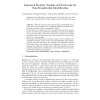Free Online Productivity Tools
i2Speak
i2Symbol
i2OCR
iTex2Img
iWeb2Print
iWeb2Shot
i2Type
iPdf2Split
iPdf2Merge
i2Bopomofo
i2Arabic
i2Style
i2Image
i2PDF
iLatex2Rtf
Sci2ools
87
Voted
ESORICS
2008
Springer
2008
Springer
Improved Security Notions and Protocols for Non-transferable Identification
Abstract. Different security notions and settings for identification protocols have been proposed so far, considering different powerful adversaries that can play "man-in-the-middle" attacks. In this paper we consider one of the strongest forms of these attacks, namely resettably non-transferable identification introduced in [Bellare et al., Eurocrypt 2001]. This notion immunizes a scheme from powerful adversaries that have physical access to the proving device and can thus reset it to a previous state. We discuss some limitations of existing notions as well as different impossibility results for strong notions of non-transferability. We introduce a strong and achievable notion for resettably non-transferable identification that reflects real scenarios more adequately and show a general protocol that satisfies it. We show how to efficiently instantiate our construction and discuss the viability of our protocol for the next generation of electronic passports (e-passports).
ESORICS 2008 | Identification Protocols | Non-transferable Identification | Powerful Adversaries | Security Privacy |
Related Content
| Added | 19 Oct 2010 |
| Updated | 19 Oct 2010 |
| Type | Conference |
| Year | 2008 |
| Where | ESORICS |
| Authors | Carlo Blundo, Giuseppe Persiano, Ahmad-Reza Sadeghi, Ivan Visconti |
Comments (0)

